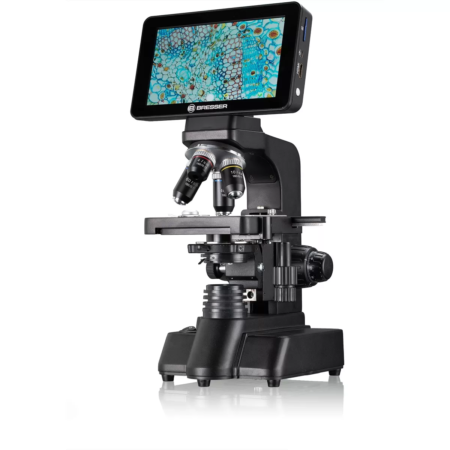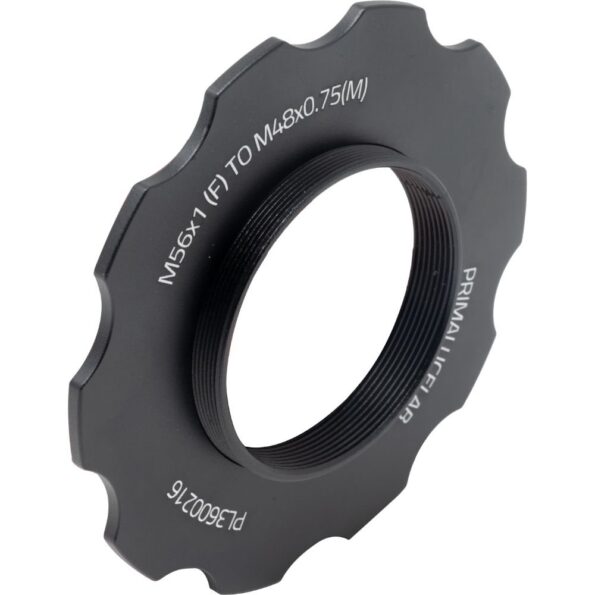Key Features
- Cooled CMOS camera with Back Side Illumintad technology with Sony sensor 533M/C in monorversion
- Sensor format, square, 3003 x 3003 pixels
- Sensor size 12, x 12.3 mm, diagonal 15.9 mm Pixel size 3.76 µm
- Quantum efficiency over 90% at 450 nanometers (monochrome sensor)
- Exposure times up to 3600 seconds
- Full well capacity 58 ke-
- Readout noise 1.3e- to 3.4 e-
- Dark current 0.0005 e-/pixel/sec at - 20 degrees
- AD conversion 14 bit
- Interface USB 3 High Speed
- Maximum frame rate 27 full frames at 8 bit and 18 full frames at 14 bit, ROI possible (depending on control computer)
- Shutter rolling shutter
- Large internal image memory with 1 GBy DDR3
- 2-stage TE cooling, 35 degrees below ambient at exposure times > 1 second
- With "Anti-Noise", "Anti Amplfier Glow" and "AntiDew" technology
- Diameter and length 90 x 107 mm (optimal for RASA and Hyperstar telescopes)
- Backfocus at 17,5 millimeter
Description
With the advantage of low readout noise and high-speed readout, CMOS technology has revolutionized astronomical imaging. The QHY533M/C is a new generation of back-illuminated CMOS cameras with 3.76um pixels. The QHY533M/C uses the similar series of sensors as the flagship models QHY600 and QHY268, featuring low noise.
Features:
BSI
One benefit of the back-illuminated CMOS structure is improved full well capacity. This is particularly helpful for sensors with small pixels. In a typical front-illuminated sensor, photons from the target entering the photosensitive layer of the sensor must first pass through the metal wiring that is embedded just above the photosensitive layer. The wiring structure reflects some of the photons and reduces the efficiency of the sensor.
In the back- illuminated sensor the light is allowed to enter the photosensitive surface from the reverse side. In this case the sensor’s embedded wiring structure is below the photosensitive layer. As a result, more incoming photons strike the photosensitive layer and more electrons are generated and captured in the pixel well. This ratio of photon to electron production is called quantum efficiency. The higher the quantum efficiency the more efficient the sensor is at converting photons to electrons and hence the more sensitive the sensor is to capturing an image of something dim.
TRUE RAW Data
In the DSLR implementation there is a RAW image output, but typically it is not completely RAW. Some evidence of noise reduction and hot pixel removal is still visible on close inspection. This can have a negative effect on the image for astronomy such as the “star eater” effect. However, QHY Cameras offer TRUE RAW IMAGE OUTPUT and produces an image comprised of the original signal only, thereby maintaining the maximum flexibility for post-acquisition astronomical image processing programs and other scientific imaging applications.
Anti-Dew Technology
Based on almost 20-year cooled camera design experience, The QHY cooled camera has implemented the fully dew control solutions. The optic window has built-in dew heater and the chamber is protected from internal humidity condensation. An electric heating board for the chamber window can prevent the formation of dew and the sensor itself is kept dry with our silicon gel tube socket design for control of humidity within the sensor chamber.
Cooling
In addition to dual stage TE cooling, QHYCCD implements proprietary technology in hardware to control the dark current noise.
QHY533M (mono) and 533C (color) have different interface designs to be more flexible to deal with different applications.
QHY533M can be directly connected to the QHYCFW3S-SR without removing any part of the filter wheel (like the filter container). This provides a very short back focal length and that’s easy to fix! Besides, QHY533M + QHYCFW3S-SR combination can be easily connected to a DSLR lens, with only one additional adapter (sold separately).
Both QHY533M/C comes with an additional adapter for tripod interface. This makes it easier to shoot with DSLR lens.
Specifications
| Model | QHY533M | QHY533C |
| COMS Sensor | SONY IMX533 M | SONY IMX533 C |
| Mono/Color | Mono | Color |
| FSI/BSI | BSI | |
| Pixel Size | 3.76um x 3.76um | |
| Effective Pixel Area | 3008*3028 (includes the optically black area and overscan area) | |
| Effective Pixels | 9MP | |
| Sensor Size | 1 inch | |
| A/D Sample Depth
|
Native 14-bit A/D | |
| Full Well Capacity (1×1, 2×2, 3×3) | 58ke- | |
| Full Frame Rate | USB3.0 Port: Full Resolution 26.5FPS @8BIT 20FPS @16BIT2160Lines 37FPS @8BIT 28.5FPS@16BIT1080Lines 71.5FPS @8BIT 55FPS @16BIT768Lines 97FPS @8BIT 76FPS @16BIT480Lines 152FPS @8BIT 117FPS @16BIT240Lines 280FPS @8BIT 215FPS@16BIT |
|
| Readout Noise | 1.3 to 3.4e- | |
| Dark Current | -20C,0.0005e- /pixel/sec | |
| Exposure Time Range | 30us-3600sec | |
| Unity Gain | 68 | |
| Shutter Type | Electronic Shutter | |
| Computer Interface | USB3.0 | |
| Built-in Image Buffer | 1GByte DDR3 Memory | |
| Cooling System | Two-stage TEC cooler
Less than 1S lower than ambient temperature -30C in continuous mode More than 1S continuous mode or lower than ambient temperature -35C in single frame mode (Test temperature +20°) |
|
| Optic Window Type | AR+AR High Quality Multi-Layer Anti-Reflection Coating | |
| Anti-Dew Heater | Yes | |
| Telescope Interface | – | Support M48 (with adapter) |
| Back Focal Length | Actual Back Focal Consumed: 14 mm (Combined with CFW)
Standard BFL: 17.5mm(±0.5) |
17mm |
| Weight | 845g | 845g |
Sample Images

Astrophotographer: @blastrophoto
Imaging telescope or lenses: Explore Scientific ED127
Imaging camera: QHY533M
Mount: Skywatcher EQ6-R Pro
Integration:
36x180s – R
36x180s – G
36x180s – B
60x180s – Lum
109x300s – Ha
Astrophotographer: Nico Carver
https://www.instagram.com/p/CbfTnKfOJwQ/
Imaging Telescopes Or Lenses: Askar FRA300 Pro
Imaging Cameras: QHYCCD QHY533M
Filter: Astrodon H-alpha 5nm, [OIII] 3nm
Integration: 2.4h
Reviews
Recommended

- In Stock





Related products
- On Back Order












0.0 Average Rating Rated (0 Reviews)